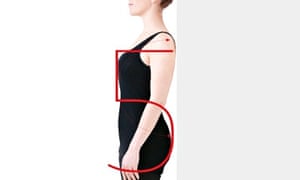If you have a medical condition or injury, consult your GP or physiotherapist before doing these exercises.
Back pain reliever (above)
Most of us spend too much time sitting down, and this shortens our anterior hip muscles (a group of muscles that attach to the front of pelvis in various ways – namely the hip-flexors, quadriceps and psoas). In turn, this pulls the pelvis forward into a tilt to the front, and can eventually lead to back pain and poor posture because it creates an exaggeration to the curve of our lumbar spine. “By stretching these muscles, we help to keep our pelvis in neutral alignment,” says Jan Keller, a postural correction specialist. If you have a lower-back ache or tightness, this may offer instant relief.
“Kneel down, then place your right leg out in front of you at a 90-degree angle. Put your hands behind your head and push your left hip forwards. You will feel the stretch through the front of your left hip and front of the thigh. Hold for 30 seconds. Don’t lean forward, but keep your shoulders over your hips.” Go back to kneeling and repeat on the other side. Try this five times a day.
Shoulder stretcher

Many of our daily activities, such as driving or working on a computer, involve reaching forward with our hands, causing our shoulders to curl and our chest muscles to shorten and tighten. Rishi Loatey, chiropractor at the British Chiropractic Association, suggests the following exercise to relieve stress from the shoulders and counteract the effects of hunching up.
“Stand with your feet just wider than hip-width apart and put your arms out to the side. Bend your elbows into a right angle, with the palms facing forward, and draw your shoulder blades together. Start making small, backwards circles with your arms and hands, keeping your shoulder blades drawn together. Once you’re into a rhythm, start swaying gently from side to side.” Try this for 10 seconds once or twice a day.
Back strengthener

This exercise from Christianne Wolff, a Pilates instructor, is excellent for strengthening the core-stability muscles that wrap around our middle and help to support the lumbar spine – weakness in them leads to poor posture.
“Get down on all fours, with your hands under your shoulders and knees under hips, eyes looking at the floor. Breathe deeply. As you exhale, lift your right arm and left leg out straight, to be level (or as close as you can get) with your body. Don’t lean into your right hip to support yourself – counterbalance by engaging your core-stability muscles instead. They’re like a corset wrapped around your middle – imagine pulling it in tight. Inhale, and lower your arm and leg back to the starting position, ensuring that both touch the floor at the same time. Exhale, and raise the opposite arm and leg. Inhale, and lower. Keep moving with each breath.” Aim for 10-20 raises in total.
Spine relaxer

This Alexander Technique exercise allows the spine to rest and regain its natural curve, enabling you to maintain better posture when you stand up again. Peter Nobes, an Alexander Technique teacher, suggests the following exercise.
“Use books to make a 6cm-9cm support for your head, or whatever feels comfortable. f your chin is dipping towards your chest, take a book away. Bend your knees to bring your feet flat on the floor, and keep the knees slightly wider than hip-width apart. Now, keeping your elbows resting on the floor, bring your hands to rest somewhere between your lower ribs and hips, wherever feels comfortable. Stay in this position for 10-20 minutes and feel your spine, slowly but surely, relax and soften.”
Stand tall

This exercise, recommended by the physiotherapist Sammy Margo, will help you combat the effects of the round-shouldered desk slump, and remind your body what it feels like to really stand up straight.
“Find a blank section of wall and stand tall up against it, with your heels touching it. Make sure that your shoulder blades and bottom are in contact with the wall. There should be a gap between your lower back and the wall, to keep its natural arch. Now try to place the back of your head against the wall by tilting your chin downwards slightly. Imagine a piece of string pulling the back of your hair up. Stand here for 30 seconds and then step away, maintaining this newly straightened posture.”
Source: Read Full Article
